

SNAP: Accelerating Toward a Decision
U.S., Chinese Experts Tackle Climate Change
SNAP: Accelerating Toward a Decision
Every year brings new members and new technical, scientific, and political challenges to the SuperNova/ Acceleration Probe (SNAP) collaboration, which now has over 140 members from 14 institutions in the U.S., Canada, and Europe.
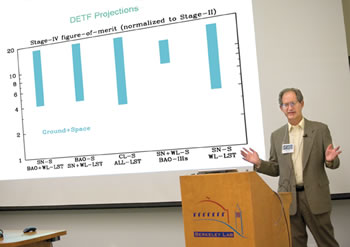 Dark Energy Task Force member Robert Cahn screens a graph showing that space-based supernova and weak lensing studies like SNAP’s plus baryon oscillation studies from the ground, when combined (second bar from right), offer the best chance for dramatic advances in knowledge about dark energy. Photo by Roy Kaltschmidt, CSO
Dark Energy Task Force member Robert Cahn screens a graph showing that space-based supernova and weak lensing studies like SNAP’s plus baryon oscillation studies from the ground, when combined (second bar from right), offer the best chance for dramatic advances in knowledge about dark energy. Photo by Roy Kaltschmidt, CSO
Lab Director Steve Chu and SNAP principal investigator Saul Perlmutter launched this year’s collaboration meeting, held at Berkeley Lab June 1 through 3, with encouraging news from all fronts.
SNAP aims to learn about dark energy by measuring the expansion history of the universe. Presently scientists cannot say whether dark energy has a constant value, has changed over time, or may even be an illusion — if accelerating expansion is caused by weakening gravity instead.
SNAP inspired the NASA/DOE Joint Dark Energy Mission (JDEM) and looks to be the leading contender in a competition that now includes several entries. SNAP welcomes the competition, said Perlmutter, “but we don’t want it to drag on.”
As NASA Administrator Michael Griffin explained at a February press conference, however, the agency took a “couple billion out of science” to fund manned spaceflight programs. The budget crunch has complicated JDEM planning.
To help NASA keep JDEM on track, Perlmutter and Chu have held meetings at the highest levels of DOE, receiving expressions of strong support. Enthusiasm for JDEM among influential members of Congress is equally strong.
One goal, said Chu, is to bring SNAP to the next stage of DOE project planning, “the stage of serious engineering design and budget. Our experience is that once a project goes to engineering, a lot of the risk goes out.”
Planning for all eventualities, Perlmutter and co-principal investigator Michael Levi are evaluating other launch options. They’ve visited Russia to inspect the Soyuz/ST, an economical launch system and the world’s most reliable. SNAP would fit neatly onto the Soyuz’s Fregat fourth stage, “a little tight on mass but doable,” Perlmutter remarked.
When Levi laid out the JDEM proposal specifications of NASA’s Research Opportunities in Space and Earth Sciences (ROSES), these too looked imminently doable, given technical tweaks. SNAP’s two main programs — the tried-and-true supernova method pioneered by the Supernova Cosmology Project and the highly promising weak lensing method — nicely fit recommendations of the Dark Energy Task Force (DETF).
Commissioned by NASA, DOE, and the National Science Foundation, DETF’s final report was submitted two days after SNAP’s collaboration meeting ended. Robert Cahn of the Physics Division, one of DETF’s 13 members, gave the collaborators a preview and inside look at how the task force reached its conclusions.
Calling dark energy “among the very most compelling of all outstanding problems in physical science,” the DETF report didn’t rank specific projects but looked at broad experimental approaches, evaluating how much each is likely to reduce uncertainty about dark energy’s properties. Four basic observational techniques were considered:
• Baryon acoustic oscillations: how dark energy has affected the distribution of matter in the universe;
• Clusters: how dark energy has influenced the density of galactic clusters;
• Supernovae: whether the rate of expansion due to dark energy has varied, measured by comparing supernova redshifts and brightnesses;
• Weak lensing: a potentially more powerful way of measuring dark energy’s effect on the distribution of matter, by observing the apparent displacement of distant galaxies when the mass of a foreground object bends their light.
Cahn emphasized that the report’s four stages of experimentation represent “stages of knowledge, not the order of experiments.”
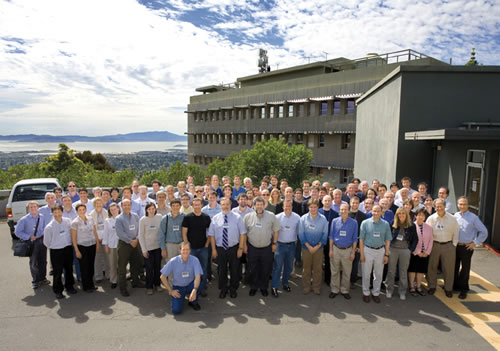 The SNAP Collaboration meeting held at Berkeley Lab during the first three days of June was the largest yet, with over 110 participants from the U.S., Canada, and Europe.
The SNAP Collaboration meeting held at Berkeley Lab during the first three days of June was the largest yet, with over 110 participants from the U.S., Canada, and Europe.
The greatest advances with the greatest reliability would likely result from a particular combination of Stage IV experiments: a space-based mission for supernovae and weak lensing, combined with ground-based baryon oscillation studies. Under optimistic assumptions, other combined programs might reduce uncertainties a bit more — but at much greater risk, with pessimistic assumptions pointing to dismal results. Cahn said one lesson comes through clearly: “combinations that don’t have weak lensing lose.”
DETF thus validates SNAP’s approach, which has included supernova and weak lensing studies from the beginning. SNAP’s technical aspects continually evolve. Detector advances allow more sensitive observations. New filter systems may further improve SNAP’s ability to determine the redshifts of distant galaxies from their colors alone, without having to identify elemental lines in their spectra, a capability essential to weak lensing studies.
Meanwhile, theory too evolves. One group of SNAP collaborators explored alternatives to dark energy scenarios and how these might be identified.
Bhuvnesh Jain of the University of Pennsylvania described modified-gravity theories involving extra dimensions of space, extra mathematical terms, extra fields, and other adjustments to General Relativity. He concluded, “There isn’t a single theory I know of that’s internally consistent and doesn’t have some problem, like superluminal velocities.” Nevertheless, he said, “It’s early in the game.”
To modified gravity — the notion that dark energy is not energy — Eric Linder of Berkeley Lab’s Physics Division added the possibility that dark energy isn’t completely dark, “that it could couple to dark matter, for example.” If so, matter distribution studies, which assume no such coupling, could yield misleading results.
Supernova studies, being purely geometric, are “super clean”; they don’t assume the nature of dark energy. Said Linder, “JDEM must include supernova studies or it will leave too many ambiguities.” It’s one way of saying that an effective JDEM equals SNAP.
Scientific consensus rapidly converges on the best methods to study dark energy. The SNAP collaboration’s challenge is to build a wider consensus, one that ensures that progress toward solving the mystery of dark energy does not falter.
U.S., Chinese Experts Tackle Climate Change
For two days last month, top climate scientists, business people, and energy experts from the two nations that spew the most greenhouse gasses into the atmosphere — China and the U.S. — met at UC Berkeley.
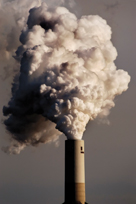
They explored ways to curb carbon dioxide emissions and fleshed out the planet-altering repercussions if humankind fails do so, such as a future plagued with rising sea levels and more droughts.
Despite the need to convert Mandarin to English, and vice versa, not much was lost in translation, thanks to all-too-clear graphs that depicted an ominous spike in global temperatures, and the unmistakable sound of urgency in speakers’ voices.
“Carbon emissions in the next 30 years will add three times more CO2 emissions than the previous 250 years,” said Berkeley Lab Director Steve Chu, one of three Lab scientists who spoke at the May 23-24 China-U.S. Climate Change Forum, which was organized by the Berkeley-China Initiative. As one of the opening speakers, Chu outlined both the magnitude of the problem and how Berkeley Lab is poised to tackle it.
“Nature has found a way to convert sunlight, CO2, water and nutrients into chemical energy,” he said, offering a glimpse into the Lab’s multidisciplinary initiative to create sustainable, carbon-neutral sources of energy. “Some of our best and brightest scientists are now willing to shift their careers and address this problem.”
But why cross oceans and strategize how to derail climate change if policymakers from both nations are reluctant to enforce greenhouse gas emission reductions? Perhaps, as chairman of the UC Board of Regents Richard Blum pointed out, the scientists and scholars who crowded the auditorium are some of the best people for the job.
“There is no question that universities here and in China must play a key a role in the debate on climate change because it has been way too politicized,” said Blum.
For many, in fact, the debate is over. According to John Harte, a UC Berkeley professor in the Energy and Resources Group, there is nearly unanimous agreement among scientists that global warming will lead to more and longer-lasting summer heat waves. He added that most scientists also agree that climate change will spark a sea level rise of at least half a meter by 2100, shrinking glaciers, reduced snowpack, and coral reef degradation.
Some impacts are already evident. Chinese scientists have determined that seven percent of the Tibetan Plateau’s ice cap disappears each year, jeopardizing the water source for several rivers including China’s Yangzi and India’s Ganges. And earlier this year, scientists reported that the amount of ice that Greenland’s glaciers dump into the Atlantic Ocean has almost doubled in the last five years, most likely due to rising air temperatures.
And this could be the optimistic view. Recently, Harte and Margaret Torn of the Earth Sciences Division reported that global temperatures at the end of this century may be significantly higher than current climate models are predicting.
Whatever happens, future generations could inherit a different planet. “This is the Anthropocene age. Humans are changing the Earth,” said C.S. Kiang, dean of Peking University’s College of Environmental Science. His blunt words were echoed by others.
“I’ve been working on this problem for 25 years, and I’m worried, very worried,” said Inez Fung, a scientist in the Earth Sciences Division and a professor of Atmo-spheric Science at UC Berkeley. “Global warming is real and happening. The science is there. The models are doing a reasonable job,” added Fung. “If I were the planetary doctor, I would tell the planet it has a fever, and the prescription is a reduction in carbon emissions.”
That’s a huge challenge, however, in a world addicted to cheap but polluting sources of energy. Mark Levine, director of the Environ-mental Energy Technologies Division and a pioneer of promoting energy efficiency in China, said that energy use in that country is growing at an extraordinary rate.
“There is a boom in power plant construction. Between 50 and 70 gigawatts are added each year, mostly coal-fired,” said Levine.
Fortunately, Levine added, the Chinese government recognizes that energy use is a problem. Last year, it stated that energy use per unit gross domestic product must be reduced by 20 percent from 2005 to 2010.
Policymakers are also slowly coming aboard in the U.S. In an impassioned speech, Terry Tamminen, special assistant to Governor Schwarzenegger for energy and environmental technologies, proposed that “we do the most rapid transition that we can possibly do from fossil fuels to renewables,” said Tamminen. “The barriers to energy sustainability and transfer from fossil fuels are the barriers in our minds.”
75th Anniversary Summer Lecture Series Kicks Off Soon
If you ever wanted a front row seat to history, then don’t miss Berkeley Lab’s 75th Anniversary Summer Lecture Series, which starts June 30 and runs to August 2. The series features six eminent scientists who have both shaped the course of Berkeley Lab and their scientific fields. They’ll discuss topics ranging from discovering what caused the extinction of the dinosaurs to the invention of the bubble chamber and breakthroughs in medical imaging and energy efficiency. Lab employees, students, and guests are invited to attend these non-technical presentations, which are held at noon in the Building 50 auditorium. Bring a bag lunch and questions.
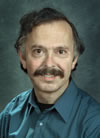
Richard Muller
The Death of the Dinosaurs — 27 Years Later
Muller, a Berkeley Lab physicist, will discuss Nobel laureate Luis Alvarez and colleagues’ 1979 discovery that an asteroid impact killed the dinosaurs. He’ll also discuss what scientists have learned in the subsequent 27 years. Alvarez’s team detected unusual amounts of iridium in sedimentary layers. They attributed the excess iridium to an impact from a large asteroid.
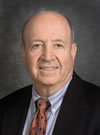
Thomas Budinger
Nuclear Medicine at Berkeley Lab: From Pioneering Beginnings to Today
Budinger, who heads Berkeley Lab’s Center for Functional Imaging, will discuss Berkeley Lab’s rich history pioneering the field of nuclear medicine, from radioisotopes to medical imaging. Among his many accomplishments, Budinger’s work led to an extremely high resolution PET scanner that was built at Berkeley Lab in 1986.
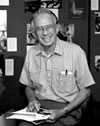
Art Rosenfeld
Energy Efficient Buildings and Appliances: From Berkeley Lab to the Marketplace
Rosenfeld, an appointee to the California Energy Commission and one of the architects of energy efficiency research at Berkeley Lab in the 1970s, will discuss what it takes to shepherd innovative energy efficiency research from the lab to the real world. Rosenfeld recently won the prestigious Enrico Fermi Award, the U.S. government’s oldest award for scientific achievement.
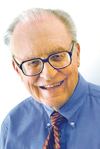
Nobelist Donald Glaser
Invention and History of the Bubble Chamber
Glaser won the 1960 Nobel Prize for Physics for his 1952 invention of the bubble chamber at Berkeley Lab, a type of particle detector that became the mainstay of high-energy physics research throughout the 1960s and 1970s. He will discuss how, inspired by bubbles in a glass of beer, he invented the bubble chamber and detected cosmic-ray muons.
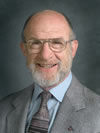
Andy Sessler
75 Years of Particle Accelerators
Sessler, Berkeley Lab director from 1973 to 1980, will shed light on the Lab’s nearly eight-decade history of inventing and refining particle accelerators, which continue to illuminate the nature of the universe. The theoretical physicist will chronicle the evolution of accelerators from Ernest O. Lawrence’s cyclotron to today’s powerful machines.
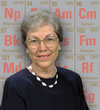
Darleane Hoffman
Discovery of the Transuranium Elements
Hoffman, a nuclear chemist, will chronicle the discovery of the heaviest elements — those much heavier than uranium and plutonium. Among her many accomplishments, Hoffman was a member of the Berkeley Lab team that in 1993 confirmed the discovery of element 106, which was named seaborgium for Nobel laureate Glenn Seaborg, a long-time colleague of Hoffman’s.
If You Come, They Will Build It (Or Paint It)
Ask the Facilities Division’s painters and cabinetmakers what the best part of their job is, and they’ll tell you it is the astonishing variety of tasks they’re asked to perform. Ask them what the toughest part of their job is, and they’ll tell you it is—well, the astonishing variety of tasks they’re asked to perform.
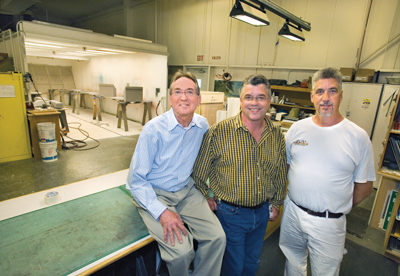 Barry Pope, left, Michael Crofoot, center, and Vic Haskett with the Facilities Division.
Barry Pope, left, Michael Crofoot, center, and Vic Haskett with the Facilities Division.
“I like to say we can do everything from artifacts to zamboni,” says Vic Haskett, a 15-year veteran painter in the Lab’s signage and painting department. “On any given week we will be juggling dozens of different jobs.”
Haskett’s duties run the gamut—from staining and finishing furniture, to making the familiar plastic room-number signs posted outside office doors, including the meticulous job of attaching—one by one— the tiny raised plastic balls used for Braille readers. Spend a little time with Haskett and you’ll see just how frenetic his day is. He bounds from his computer, where he works the software programs that help him create public signage to exacting specifications, to the paint shop where he is painstakingly finishing a wooden bookcase to a perfect sheen and painting new feet for the bubble chamber so it can return to its perch outside Building 50.
His shop makes the vinyl banners that announce safety and blood drives, creates signage for the Lab’s public areas and laboratories, and paints Lab buses and police cars with their signature blue logo and pinstriping. If it gets painted or finished, it is likely to have passed through the paint shop’s domain, handled by either Haskett or his co-workers, Joe Cullen and Ignacio Sanchez. “We’re a service group,” he says. “If you need it, we’ll find a way to do it.”
A Brave New World for Painters
After 23 years in the Lab’s painting group as an interior/exterior painter, Barry Pope is set to hang up his apron and retire at the end of June. He says the Lab is like no place he’s ever worked on the outside.
“There is no getting comfortable in your job when you have the mind-bending variety of work that we have here on the hill,” Pope says. “There’s so much in preparation alone.” Between dodging research experiments, following exacting environmental and safety specs, sanding, prepping and painting, a painter has got to be high energy. “I’m Type-A,” Pope says pacing back and forth to prove it. There is no getting complacent when you could be hanging from scaffolding painting the Bevetron building one day and painstakingly trimming out the inside of an office the next.
“Every day you show up to work it’s something new,” he says. “Up here a painter has to know so much more than out in the civilian world.” So what is Pope going to do when he doffs his painter’s hat? “Until at least December, I’m just going to do nothing,” he says smiling.
Master Builders Meet Their Match
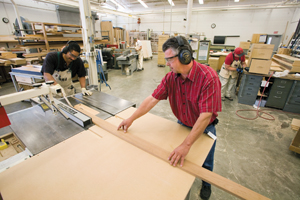 Crofoot, foreground, Gerald Martin, left, Warren Elliott, in background with white overalls, and John Souza, far right.
Crofoot, foreground, Gerald Martin, left, Warren Elliott, in background with white overalls, and John Souza, far right.
For 15 years cabinetmaker Michael Crofoot has built every conceivable concoction that could be fabricated in wood, aluminum, plexiglass or laminate. “It doesn’t matter how complicated it might be, if you can dream it up and communicate it to us, we can build it,” Crofoot says. “We’re flexible, and we’re competitive. We can make it high-end or inexpensive, depending on a customer’s needs. We can build a complex microscope table that will help control vibrations, or a single shelf for your books.” With the help of three other cabinetmakers, Warren Elliott, Gerald Martin, and John Souza, Crofoot’s shop handles about 20 jobs a week. A typical office construction can usually be turned around in about 3 weeks.
Using specialized software, he can model any design a customer requests to show them what the furniture will look like when finished, and he has a prodigious portfolio of completed jobs to choose from in the event someone isn’t sure what they need. Walk through the Lab and its farther flung satellites like Potter Street, and you’ll see the results of the cabinetmakers’ handiwork. Whether it’s customized lab benches, exhibit display cases, office furniture, kitchens, or custom-made containers for exotic scientific equipment, Crofoot and his team have made them. He prides himself on the flexibility of their work—they design modularly to adapt preconfigured designs to customized needs—that saves customers money and time.
Which job posed one of the cabinetmakers’ biggest challenges?
“They were putting together the front end of the SNS,” he says, “and they asked me to come up and look at it, because they needed to have containers built to ship it. I walked into the room and I couldn’t believe my eyes. It was the biggest, most complex piece of equipment I’d ever seen; I didn’t have any idea where to start. They told me, ‘Well, this piece here will come off, and this cylinder here will have to ship separately,’ and when it was all done, we managed to make containers to fit every piece and ship it safely. That was a challenge.”
Oh, and those new feet for the bubble chamber? Crofoot’s shop made those too.
The Lab’s cabinetmakers work alongside 13 carpenters, who perform tasks from roofing to making new keys, all overseen by supervisor John Tully. Dave McPherson supervises the paint and sign shop. You can tap the expertise of the shops for all your needs by contacting the Work Request Center on the web, or at X6274.
Blackberry Gate Transformation Begins This Summer
From a summer of traffic inconvenience will flow a much safer, more efficient access to Berkeley Lab.
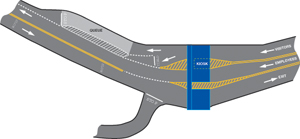 The current Blackberry Gate (below right, patrolled by guards James Hicks, at left, and David Kusch) will undergo an upgrade which includes a modernized guard kiosk and lane adjustments to allow for more effecient access. In illustration above, visitors and employees will in the future enter on opposite sides of the kiosk. A lane for truck and visitor queues will also be added.
The current Blackberry Gate (below right, patrolled by guards James Hicks, at left, and David Kusch) will undergo an upgrade which includes a modernized guard kiosk and lane adjustments to allow for more effecient access. In illustration above, visitors and employees will in the future enter on opposite sides of the kiosk. A lane for truck and visitor queues will also be added.
Beginning in the next few weeks, contractors will begin excavating the hillside just south of the Lab’s main Blackberry Gate, the first stage in a major renovation that will feature an additional in-bound lane, a new kiosk, better signage and more vibrant street striping. The fixes should mean less waiting time for employees entering the Lab in cars or trucks, especially during commute hours, and the wider access and egress will give vehicles, bicyclists, pedestrians and guards a safer environment. The current practice of having to pass stopped vehicles on the left-hand side will be eliminated.
The final product is due in late October, but construction and roadwork mean inevitable delays, lane changes and parking dislocations throughout the summer. All employees are urged to proceed with caution during these transitional months, and to use the alternative entrances off Centennial Road (Strawberry and Grizzly) whenever possible. Blackberry probably won’t ever close completely, but one-lane traffic and flagman-controlled access can be expected.
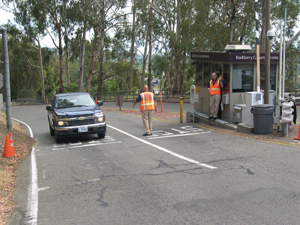
The project’s initial phase — cutting back the hillside, hauling the dirt to the other side of the Lab for landfill, and installation of a new lane will last several weeks. That lane, which will hug the hillside past the gate, will be the new visitors’ access and temporary parking lane for trucks during inspection. Employees will enter via an unobstructed entrance lane to the left of the new kiosk, separated from the visitors’ lane and ensuring more rapid access.
Drivers can expect existing access lanes to change, with employees entering the Lab from the left side of the kiosk and visitors checking in on the right side. The so-called “horseshoe” parking lot on the Cyclotron Road curve will be the staging area for all construction during the project, and its 25 parking spots will be unavailable into the fall.
In the next phase comes the installation of a new, upgraded kiosk for the security guards, removal of the old kiosk and pad, and additional roadwork while a transformer replacement and security camera upgrades will bring the technology up to standards. This phase will take another few weeks, and during that time, traffic lanes will be adjusted to accommodate the construction.
The last phase will include the installation of the smaller kiosk pad, addition of guard rails, bollards, walkway and lane striping, and final paving.
For safety reasons, the “Seaborg Steps,” a popular pedestrian hillside route up to buildings 50 and 70A from Cyclotron Road inside the gate, will be closed throughout the construction period. But when the project is completed, the steps will lead to a new brightly defined crosswalk that will take pedestrians across the road to the downhill walkway.
During most of the construction, areas above and below the kiosk will be reduced-speed zones, a 15-mph maximum for both vehicles and bicycles. Bikes might be especially vulnerable to uneven pavement surfaces and construction debris, so caution is urged.
Site Access Manager Jim Breckinridge encourages the use of both Strawberry and Grizzly gates throughout the construction. Strawberry will be open from 5:45 a.m. to 8 p.m., and Grizzly is open as an entrance from 6:30 to 9:30 a.m. Grizzly is available for exiting through an electronic trip gate all day and night.
Funds for the project came from the Department of Energy’s Safeguards and Security Office.
For questions about the project, contact coordinator Jack Heffernan in Facilities at x5993.
The 1980s — Emergence of a National Multiprogram Institution
A legacy of achievement: ALS, NCEM and a Nobel Prize
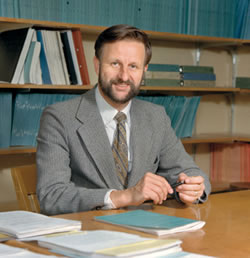 David Shirley, Lab director 1980-89
David Shirley, Lab director 1980-89
For better or worse, the 1980s is probably most remembered as the decade of the “me” generation. It was a time when yuppies — young urban professionals — “shopped till they dropped,” and terms like “hostile takeovers,” “leveraged buyouts,” and “mega-mergers” were added to the public lexicon. “If you’ve got it, flaunt it!” was the clarion call, despite the fact that the decade began with a national economy groaning under the weight of double-digit inflation. In 1981, there came with little fanfare a report from the Center for Disease Control about a mysterious new syndrome that seemed to be attacking the immune systems of gay men. The 1980s saw the 200th anniversary of the U.S. constitution and the birth of MTV. President Ronald Reagan dominated the national political scene, and the 1980 winter Olympics featured a “miracle on ice,” when the U.S.A. hockey team struck gold against all odds.
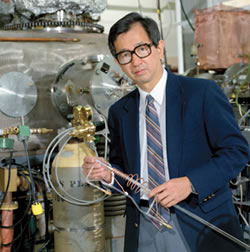 Yuan Lee, winner of 1986 Nobel Prize in chemistry
Yuan Lee, winner of 1986 Nobel Prize in chemistry
In the world of science and technology, there were headline-making achievements, like the discovery of high temperature superconductors and the launching of the Columbia space shuttle, and headline-making frauds, like cold fusion. More and more people began using personal computers at work and in their homes, and by the end of the decade a medium through which all these new computer users could share information was created, called the World Wide Web. And at the Lawrence Berkeley Laboratory, or LBL as it was widely known, for the first time in the institution’s history a chemist rather than a physicist was chosen to be director.
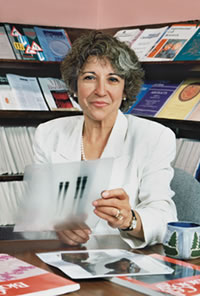 Mina Bissell, author of the ECM theory of breast cancer
Mina Bissell, author of the ECM theory of breast cancer
David Shirley was not only the first chemist to direct the Lab, he was also the first director without a background in accelerators. A native of New Hampshire and graduate of the University of Maine, Shirley began working at the Lab in 1958, a year before he got his Ph.D. in chemistry from UC Berkeley. He rose quickly through the ranks as a scientist, winning the prestigious E.O. Lawrence Award in 1972 at the age of 37, for his investigations into the chemical nature of matter. When UC President David Saxon chose him as the successor to Andrew Sessler, he was 45. Shirley took over the directorship just as the Laboratory was plunged into a deep funding crisis. President Reagan’s emphasis on defense R&D spending resulted in substantial financial reductions that forced Shirley to spend his first two years as director trying to manage the worst cutbacks in the Lab’s history. After seeing scientifically solid initiatives rejected because of political considerations, Shirley became savvy enough about Washington to hire Capitol Hill veteran Martha Krebs, who would later become the longest serving head of DOE’s Office of Science. The funding crisis subsided in 1982 thanks to Congressional actions, and Shirley began what would be a decade-long transition. The goal was to take the diversification in research programs begun by Sessler in the 1970s and bring it to full bloom on a nationally recognized level.
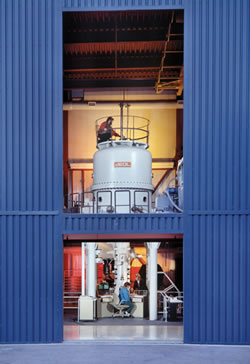 NCEM houses some of the world’s most powerful electron microscopes
NCEM houses some of the world’s most powerful electron microscopes
Shirley’s first success came in 1982 when DOE approved an initiative called the Center for Advanced Materials (CAM). Research at CAM was to be tied directly to the most critical needs of U.S. industry, aimed at solving “stopper problems” in materials science that were blocking technological developments. Funding for the CAM initiative helped start construction of the Surface Sciences and Catalysis Laboratory (Bldg. 66) and the Advanced Materials Laboratory (Bldg. 2), the first buildings constructed on the Hill in nearly 20 years. It also helped launch the Center for X-Ray Optics (CXRO), the first research facility aimed exclusively at an expanse of the electromagnetic spectrum stretching from extreme ultraviolet light to soft (low-energy) x-rays called the XUV. Wavelengths of light in the XUV range are ideal for studying and manipulating atoms and molecules at the surfaces of materials, where most chemistry takes place. XUV light is also ideal for studying material properties at nanoscale dimensions.
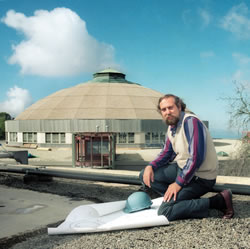 Jay Marx served as project director for the ALS construction
Jay Marx served as project director for the ALS construction
Spurred by his own scientific interest in the use of XUV light, and his success with the CAM initiative, Shirley, in 1984, put forth the initiative that would become his defining achievement as director. This initiative proposed construction of a new electron synchrotron with a storage ring designed to accommodate special magnetic “insertion devices,” called wigglers and undulators, that would enable it to produce XUV radiation with scientific properties never before attained. The new synchrotron, the first big accelerator to be constructed at Berkeley Lab in nearly three decades, was to be called the Advanced Light Source (ALS).
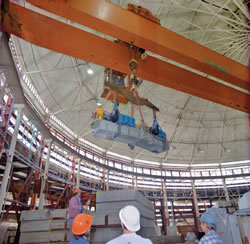 Section of the ALS booster being loaded into the shielding enclosure
Section of the ALS booster being loaded into the shielding enclosure
Shirley and the Lab faced an uphill battle for the ALS. Skeptics called it “Shirley’s Temple” and many in the scientific community questioned the value of a synchrotron optimized for the production of XUV light. But the scientific case for the ALS was fundamentally sound, and Shirley, with help from Krebs and others, was able to procure a recommendation for construction from DOE’s Energy Research Advisory Board to then Secretary of Energy John Herrington. On July 28, 1988, ground for the ALS was broken at the site where Ernest Lawrence’s 184-Inch Synchrocyclotron had stood. The landmark dome that had topped the building which housed Lawrence’s historic accelerator was preserved and refurbished so that it would also top the new ALS building. Construction of the $100 million synchrotron would be led by Jay Marx, a physicist who’d directed the PEP-4 project, one of the largest particle physics experiments of its time.
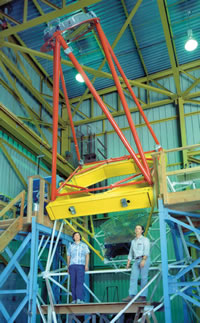 Ten Meter Telescope reference mirror
Ten Meter Telescope reference mirror
Although the ALS would come to symbolize the Shirley directorship, it was but one example of the institutional transitions that took place during the 1980s. On Sept. 30, 1983, the National Center for Electron Microscopy opened for business. Designated as a DOE national user facility, meaning its resources were made available to qualified researchers across the country, NCEM featured two of the world’s most powerful transmission electron microscopes, the million-electron-volt Atomic Resolution Microscope (ARM) and the High Voltage Electron Microscope (HVEM). Earlier that year, the Lab also opened the Center for Computational Seismology, to serve as a national and international source of information on seismic data, and the Neutral Beam Engineering Test Facility, which was to provide a national test bed for the study of neutralized particle beams, used to heat magnetically confined plasmas to the 100-million-degree temperatures needed for controlled fusion.
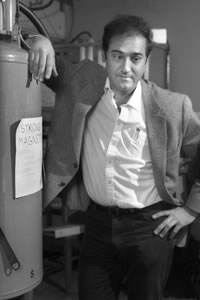 Alex Pines broke new ground in NMR technology
Alex Pines broke new ground in NMR technology
In addition to providing research facilities that served as national scientific resources, Laboratory scientists also began increasingly directing their own investigations toward problems of nationwide concern. For example, the research begun by John Lawrence to apply accelerator beams to the treatment of cancer and other diseases continued to bear fruit, most notably in the spectacularly successful treatments of ocular melanoma, led by Dr. Joseph Castro and Dr. William Saunders, and arteriovenous malformations (AVMs), inoperable blood clots deep inside the brain, led by Dr. Jacob Fabrikant. However, other Lab researchers also began investigating the causes of cancer. Based on her studies of the behavior of healthy and malignant cells in culture, Lab scientist Mina Bissell proposed that cancer was a multi-step process rather than the result of any one oncogene. She went on to identify a link between breast cancer and the extracellular matrix (ECM), a network of fibrous and globular proteins that surround and support breast cells. Subsequent research revealed how a cell’s micro-environment plays a dynamic role in its growth and development as well as in the onset of malignancies and other diseases. In another significant development, the team of Jack Bartley and Martha Stampfer presented the first experimental evidence linking the environmental pollutant benzo(a)pyrene, a by-product of fossil-fuel burning, to breast cancer.
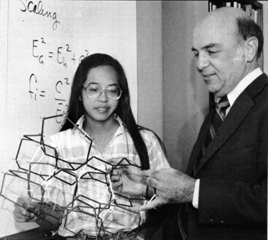 Marvin Cohen and Amy Liu with model of superhard carbon nitride
Marvin Cohen and Amy Liu with model of superhard carbon nitride
Lab researchers further boosted the institution’s reputation in the biological sciences with significant new findings in the study of heart disease and Alzheimer’s disease, and in helping to characterize the role of oxygen radicals in aging and disease. In recognition of the institutional strides made in the biological sciences, the Lab was selected in 1987 as one of two centers for the massive undertaking that was DOE’s Human Genome Project, the national effort to map and sequence the entire complement of human DNA, often referred to as the Holy Grail of biology.
Under Shirley’s watch, the Lab also continued to make a name for itself in environmental studies. Tony Hansen designed a device called an aetholometer that could for the first time make real-time measurements of the vertical distribution of soot particles cast up into the atmosphere by the burning of coal and oil. Hansen’s device was used to reveal layers of soot above the arctic ice cap in concentrations comparable to those found above urban areas. Another team of Lab scientists led by Anthony Nero helped characterize the risks posed to homes by radon, a radioactive Noble gas that can seep into homes from the soil. Still another Lab team identified selenium contamination from irrigation drainage as the reason wild birds were being poisoned to death at the Kesterson Reservoir in the San Joaquin Valley.
 The arctic ice cap lies beneath a layer of atmospheric soot as might be found above busy city
The arctic ice cap lies beneath a layer of atmospheric soot as might be found above busy city
The Lab’s expanding scientific reach was even extending to the stars. The concept of a honeycomb array of 36 hexagonal mirror segments that would act in unison as a single light-collecting telescope mirror measuring 10 meters (400 inches) in diameter, proposed by Lab physicist Jerry Nelson and supported through Director’s Funds, first by Sessler and then by Shirley, was brought to fruition in the early 1980s with the construction and successful testing at the Lab of a prototype segment. Nelson’s dream would be realized in full when, with a multimillion dollar grant from the W. M. Keck Foundation, ground was broken atop Mauna Kea, Hawaii in 1986 for construction of what would be the world’s largest optical and infrared telescope.
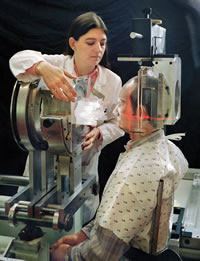 Cancer patients were treated at the Bevalac with the help of a plastic head positioner and beam compensator
Cancer patients were treated at the Bevalac with the help of a plastic head positioner and beam compensator
No look back at the Laboratory during the 1980s would be complete without noting the award-winning technological breakthroughs achieved by chemist Alexander Pines in Nuclear Magnetic Resonance, and physicist John Clarke, in the development of SQUIDs — superconducting quantum interference devices; the compressed matter theories of Marvin Cohen that would successfully predict a material, carbon nitride, harder than diamond; and the design and construction of a differential microwave radiometer (DMR), led by physicist George Smoot, for measuring temperature variations in the cosmic background radiation, which was launched aboard NASA’s COBE satellite in the summer of 1989.
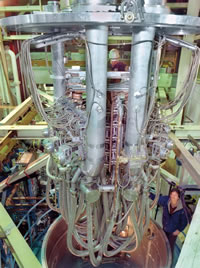 The Neutral Beam Engineering Test facility was used in the development of magnetic confinement systems for fusion energy studies
The Neutral Beam Engineering Test facility was used in the development of magnetic confinement systems for fusion energy studies
But perhaps the most notable of all the scientific achievements at the Lab during the 1980s came on Dec. 10, 1986, when the Royal Swedish Academy of Science announced that Lab chemist Yuan Lee would share that year’s Nobel Prize in chemistry. Lee became the Lab’s ninth Nobel laureate for his development of “crossed molecular beams” to study chemical reactions. In this technique, two beams of selected molecules are accelerated to supersonic speeds then sent on a collision course in a vacuum to create a chemical reaction. When the beams hit, the angles at which the resulting products are scattered and the energy released reveal much about the nature of the reaction. Understanding the hows and whys of chemical reactions has been the driving force in the study of chemistry ever since ancient alchemists tried turning lead into gold.
Shirley stepped down as Lab director on Aug. 31, 1989, with the knowledge that the transition to a national multiprogram institution had been completed. His stewardship, like his appointment to the directorship, had represented a break with Laboratory tradition. The appointment of his successor would represent another break with tradition in that for the first time ever, someone outside of the Laboratory was named to lead it.
Next: The Charles Shank Years
Berkeley Lab Science Roundup
A spring downpour of science from Berkeley Lab has brought discoveries ranging from the mammoth-hunting past to the global-warming future.
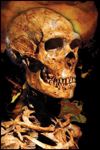 Newly sequenced parts of the genome of Homo neanderthalinsis may yield new knowledge about human evolution.
Newly sequenced parts of the genome of Homo neanderthalinsis may yield new knowledge about human evolution.
Sequencing the Neanderthals
They’re not selling tickets to Paleolithic Park yet, but a sequence of nuclear DNA 75,000 base pairs long was obtained from a Neanderthal skeleton by Eddy Rubin, director of the Genomics Division and the Joint Genome Institute, and postdoc James Noonan. Together with a million base pairs of DNA fragments sequenced by a colleague, the data point the way to learning how Homo neanderthalinsis differs from Homo sapiens on the genomic level — including when differences in hair and skin color arose, when certain diseases first appeared, and when the two species last shared a common ancestor. Next step, the full genome. “In ten years, we hope to have ten Neanderthal genomes,” said Rubin, in a report in the 18 May issue of Nature.
And the Winning Bacterium is...
Methanosarcina barkeri, a methane-producing organism that lives in cow stomachs and digests cellulose and other tough plant stuff, is the one-hundredth microbial genome to be sequenced by the Joint Genome Institute, as announced at the May 23 meeting of the American Society of Micro-biology. JGI has sequenced more organisms than any other facility, from fungus to fugu fish to, well, Neanderthals, but microbes hold a place of honor, said Office of Science Director Ray Orbach. “Many are of critical importance to DOE because they can break down plant materials to produce such useful sources of energy as ethanol and hydrogen, and clean up toxic waste sites.”
Underestimating Global Warming
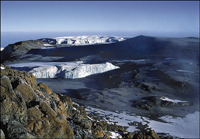 By current estimates the snows of Kilimanjaro will be gone in 20 years, but global-warming feedback loops may melt them even sooner.
By current estimates the snows of Kilimanjaro will be gone in 20 years, but global-warming feedback loops may melt them even sooner.
“The future is going to be hotter than we think,” says Margaret Torn of the Earth Sciences Division. She and UC Berkeley professor John Harte have analyzed feedback loops between temperatures and levels of greenhouse gases for the last 700,000 years, by studying carbon dioxide and methane trapped in ice cores from Antarctica. They found that warming trends caused by an increase of these gases triggered release of even more gas, driving temperatures higher, faster than today’s models anticipate. The feedback loops work in reverse, too, but “we are already near the highest temperatures of the past 700,000 years,” says Torn. “At this point, mitigation of greenhouse gas emissions is absolutely critical.” The research appeared in the May issue of Geophysical Research Letters.
Fantastic Voyage
Picture a bacterium that swims through the bloodstream to find tumors, drills into them, infiltrates the cancer cells, and only then releases deadly toxins. Adam Arkin, J. Christopher Anderson, and Christopher Voigt of Physical Biosciences, with UCSF colleague Elizabeth Clarke, have built a prototype tumor torpedo by linking an E. coli oxygen sensor with a penetrator protein from another bug, work reported in the Jan. 27 issue of the Journal of Molecular Biology. Now they’re adding a lactic acid sensor for specificity and a stealth lipid coating to evade the immune system. Next step: an enzyme to convert a drug precursor into a cancer-killing toxin.
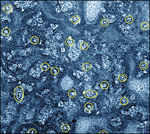 Gas and water flow through carbon nanotubes embedded in ceramic many times faster than through commercial membrane filters and may reduce the cost of desalination.
Gas and water flow through carbon nanotubes embedded in ceramic many times faster than through commercial membrane filters and may reduce the cost of desalination.
Nanoscale Mass Transit
Half the world’s desalination plants remove salt from seawater by forcing it through membranes at high pressure, an expensive process. Membrane filters that use superslick carbon nanotubes could bring the cost down dramatically. Embedded in ceramic, nanotubes less than two nanometers in diameter allow gas and water flows several orders of magnitude greater than commercial membranes. The new filter was invented by a team from Livermore Lab, Berkeley Lab, and UC Berkeley, including Costas P. Grigoropoulos of the Environ-mental Energy Technologies Division, and was reported in the May 19 issue of Science.
The Power of Positive Thinking
Indium nitride is one of the most promising and frustrating of semiconductors. Promising because when alloyed with gallium nitride it could produce the world’s best solar cell. Frustrating because it won’t conduct positive charges, and without “p-type” indium nitride there will be no such solar cell. Now Wladek Walukiewicz and colleagues from the Materials Sciences Division and Cornell University have proved that p-type indium nitride can be made, although challenges to making it practical remain. “We’re optimistic,” Walukiewicz says. “Otherwise we wouldn’t be doing this.” The research appeared in the March 31 issue of Physical Review Letters.
Can Cleaning House Kill You?
 Using some cleaning products and air fresheners repeatedly or in confined spaces may be hazardous to your health.
Using some cleaning products and air fresheners repeatedly or in confined spaces may be hazardous to your health.
It’s the excuse Dagwood was hoping to hear: household cleaners may emit harmful levels of toxic pollutants, particularly if used repeatedly or in poorly ventilated spaces. The pine and citrus odors in some products signal the presence of glycol ethers; others contain different chemical dangers. Cleaning agents’ impacts on indoor air chemistry were the subject of a four-year study led by William Nazaroff of the Environmental Energy Technologies Division, sponsored by the California Air Resources Board and released May 10. Nazaroff doesn’t advocate letting the house go to the dogs, but he warns that “what is advertised as being organic and green and good for us isn’t automatically so.”
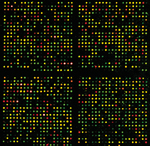 A new algorithm uses data from DNA microarrays to derive information about the complex process of gene regulation in humans.
A new algorithm uses data from DNA microarrays to derive information about the complex process of gene regulation in humans.
Cracking the Transcription Code
DNA sequences contain a lot more information than genes alone. Transcription factors regulate how genes are expressed and play a big role in, for example, differentiating a liver cell from a brain cell. But learning how they work in humans is a much harder problem than understanding how they work in simpler organisms. A new algorithm that quantifies the effect of transcription factors on human gene expression and could accelerate discovery of new therapeutics has been developed by Debopriya Das of the Life Sciences Division, with colleagues at Cold Spring Harbor Laboratory and Washington University, and published June 6 in the online journal Molecular Systems Biology.
A new algorithm uses data from DNA microarrays to derive information about the complex process of gene regulation in humans.
— by Paul Preuss
Gearing up for a Gathering Storm in California
Friday, June 2, saw leading educators, industry representatives, state administrators, members of national laboratories, and officials from the Department of Energy gather under the aegis of the California Council on Science and Technology (CCST) to brainstorm ways of “Harnessing the Capacity of California’s Federal Laboratories: Innovation and Education.” Or as CCST’s executive director, Susan Hackwood, put it, “to come up with an agenda to maintain leadership.”
“CCST is the state’s equivalent of the National Research Council, advising on issues of science and technology,” she explained. “Recently we explored the huge impact that federal laboratories have on matters crucial to the state and its economy, including energy, nanotechnology, biotechnology, and homeland security.”
Hackwood reported that Governor Schwarzenegger asked CCST “to mobilize a California response to Rising Above the Gathering Storm.” The National Academies report, which Berkeley Lab director Steve Chu helped write, argues for changes in education, research, and policy if the U.S. is to maintain its science and technology edge.
Peter Faletra, DOE’s director of Workforce Development for Teachers and Scientists, kicked off discussion of the changes needed to reduce red tape that makes it difficult for federal laboratories to work with schools and industries. He told of learning about “the national labs’ long history of developing what industry will be doing 10 or 15 years later.”
Tech transfer occupied the meeting’s morning session, organized by Cheryl Fragiadakis, head of the Lab’s Technology Transfer Department. Education was the focus during an afternoon session organized by Rollie Otto, head of the Lab’s Center for Science and Engineering Education.
“Things are coming together as they never have before," said one participant, sensing a paradigm shift in attitudes towards science education and tech transfer, when Karen Scott, Sandia Lab's government relations manager, reported on the progress of bills in Congress directly inspired by the Gathering Storm report. These include the PACE bills (Protecting America's Competitive Edge) in the House of Representatives, and Senate bills that embody President Bush's American Competitiveness Initiative.
Four Lab Employees Receive DOE Mentoring Awards
While experts at the California Council on Science and Technology conference discussed ways to maintain the state's scientific leadership (see story at left), four Berkeley Lab employees were honored for work that just may help achieve that goal.
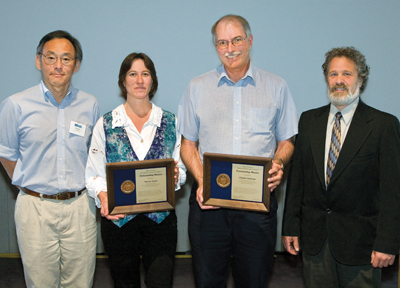 From left to right, Chu, Gauny, Verboom, and Faletra
From left to right, Chu, Gauny, Verboom, and Faletra
During the conference's lunch session, Stacy Gauny, Amy Kronenberg, both with the Life Sciences Division, Thomas Kirchstetter, with the Environmental Energy Technologies Division, and Charles Verboom, with the Information Technology Division, each received Department of Energy Outstanding Mentor Awards.
The honor recognizes their "willingness to share knowledge and inspire and instill confidence in the next generation of scientists and engineers." They each received a plaque signed by DOE Director Samuel Bodman.
Lab Director Steve Chu, along with DOE's Peter Faletra, presented the awards to the four for their mentoring of interns, who visit the Lab as part of the Undergraduate Research Program, which is managed by the Center for Science and Engineering.
People, Awards, and Honors
EETD’s Melis, Berkeley Students Win Biz Award
 Melis
Melis
An alternative energy company has won the $25,000 first prize at the eighth annual UC Berkeley Business Plan Competition. Aurora BioFuels presented a plan showing how to create bio-diesel fuel with yields 125 times higher than existing bio-diesel conversion technologies, and at half the cost. The winning team is comprised of Berkeley Lab Environmental Energy Technologies researcher Tasios Mehlis and UC Berkeley students Matt Caspari, Guido Radaelli, and Bert Vick.
Top Quark Post-Doc Wins Thesis Award
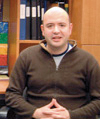 Arguin
Arguin
Jean-Francois Arguin, a post-doctoral fellow with Berkeley Lab’s Physics Division, is the winner of the 2006 Universities Research Association (URA) Thesis Award. His thesis, “Measurement of the Top Quark Mass with In Situ Jet Energy Scale Calibration Using Hadronic W Boson Decays at CDF-II,” produced the world’s best measurement of top quark mass.
Four Employees Win DOE Mentor Awards
To recognize their “willingness to share knowledge and inspire and instill confidence in the next generation of scientists and engineers,” four Berkeley Lab employees were given Outstanding Mentor Awards by the Department of Energy’s Office of Science. The winners include Thomas Kirchstetter (Environmental Energy Technologies), Stacey Gauny and Amy Kronenberg (Life Sciences) and Charles Verboom (Information Technology).
Life Sciences’ Chatterjee Gets Rad Research Honor
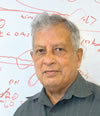 Arguin
Arguin
Life scientist Aloke Chatterjee has been awarded the 2006 Failla Award and Lectureship by The Radiation Research Society Awards and Honors Committee. The Failla award was established to honor the late Gioacchino Failla, one of the founding fathers of the Radiation Research Society and its second president. The award is given annually to an outstanding member of the radiation research community in recognition of a history of significant contributions to radiation research.
Post-Doc Receives Physics Thesis Accolade
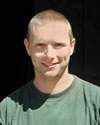 Arguin
Arguin
Cameron Geddes, a post-doctoral student in the Accelerator and Fusion Research Division, has received the 2006 Marshall N. Rosenbluth Outstanding Doctoral Thesis Award sponsored by the American Physical Society’s Division of Plasma Physics. The award recognizes exceptional young scientists who have performed original doctoral thesis research of outstanding scientific quality and achievement in the area of plasma physics. His thesis reported experimental and computational studies of channel guided laser wakefield accelerators.
In Memoriam
Gregory Traynor
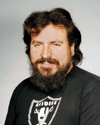 Traynor
Traynor
Gregory Traynor, a former Lab scientist with the Environmental Energy Technologies Division, passed away June 9 after a battle with pancreatic cancer. Traynor, 51, worked at the Lab from 1975 to 1998. He was part of EETD’s Indoor Air group and played softball for the Lab’s champion Ballpark Estimates team. He also worked with handicapped children and provided coaching at the Special Olympics. He received a BA in physics and MBA from UC Berkeley. Traynor is survived by wife Jeana, daughter Chelsea, and son Jared. Contributions may be made to the Children’s Hospital Foundation, 747 52nd St. Oakland, CA 94609.
Berkeley Lab View
Published once a month by the Communications Department for the employees and retirees of Berkeley Lab.
Reid Edwards, Public Affairs Department head
Ron Kolb, Communications Department head
EDITOR
Pamela Patterson, 486-4045, pjpatterson@lbl.gov
Associate editor
Lyn Hunter, 486-4698
STAFF WRITERS
Dan Krotz, 486-4019
Paul Preuss, 486-6249
Lynn Yarris, 486-5375
CONTRIBUTING WRITERS
Jon Bashor, 486-5849
Allan Chen, 486-4210
David Gilbert, (925) 296-5643
DESIGN
Caitlin Youngquist, 486-4020
Creative Services Office
PHOTOGRAPHY
Roy Kaltschmidt, 486-5731
Creative Services Office
Berkeley Lab
Communications Department
MS 65, One Cyclotron Road, Berkeley CA 94720
(510) 486-5771
Fax: (510) 486-6641
Berkeley Lab is managed by the University of California for the U.S. Department of Energy.
Online Version
The full text and photographs of each edition of The View, as well as the Currents archive going back to 1994, are published online on the Berkeley Lab website under “Publications” in the A-Z Index. The site allows users to do searches of past articles.
Flea Market is now online at www.lbl.gov/fleamarket